Time: Eric Sloane’s Chauncey Peak, Connecticut And Aviation
Aerial view. Artist. Author. Weather watcher.

Eric Sloane's wall-sized rendition of an ancient rift valley as seen from a bird's-eye view above Chauncey Peak, the rock outcrop at right. Trails lead up from what is now known as Giuffrida Park.
Eric Sloane (birth name Everard Jean Hinrichs) created an amazing life with notable accomplishments in diverse fields, including writing books, creating art, studying weather, how old barns and early houses were sited to weather conditions and much more. Yes, even helping preserve The Grange, Alexander Hamilton's home. Painting a masterwork, his view of Chauncey Peak in Meriden, Connecticut – created when many never even knew the rocky promontory existed.

Detail of the signature of Eric Sloane as seen on the Silver City/Chauncey Peak view painting.CB/MDP
The sweeping views that can be seen from the mountain top known as Chauncey Peak include the distinctive Hanging Hills of Meriden to the west, a patchwork of human development squares seen below with a minuscule white church steeple.
Sloane chose a bird's-eye-view above the rocky peak to immortalize inside the (then) corporate headquarters of International Silver Company. From all the possible landmarks, vantage points and manmade accomplishments, Sloane picked this one-of-a-kind natural formation above an ancient rift valley formed by volcanic forces millions of years ago – as his subject.
Meriden, Connecticut, was then known around the globe as “The Silver City” – and Sloane included those three words in his painting.

The farmhouse (still there but updated) and the barn and outbuildings below as seen in 1978. The old traffic tower, now restored and back downtown in Meriden, was also here, on its side in a nearby field.
Who cares? Let's provide some world-view context.
You might see more value in his work if you knew that Sloane is the same artist who was commissioned to do a six-story wall mural for the Smithsonian Institution (SI) National Air and Space Museum, Washington, D.C. – to represent the “freedom and environment of flight” – a cloudscape with a lone plane as a visual tribute to aviation history and human pioneers. (For some eye-popping statistics for visitors – you'll have to ask about the mural if it's currently on view – here's the link to the SI newsdesk reports for so far in 2017 – National Air and Space Museum alone – 1.2 million.)
Resilient. Adaptable. Visionary. Author. Artist. Curiosity harnessed. Restless and opinionated, he had a home in Connecticut, another in New Mexico. Appreciative of the ever-changing science of weather, cloudscapes. Sloane could reverse engineer a covered bridge and “see” inside structures such as barns to reveal the pure function behind the forms.
His tribute to America’s spacious skies summed up, thus: “Sloane captured the essence and variety of weather above the panoramic landscape of the American Southwest. It is Sloane’s largest and most well-known cloud painting.” – Smithsonian Institute

Sloane's painting is featured on the inside front cover of “Celebrating The National Air and Space Museum” (1976) Smithsonian Institution booklet, published by CBS.
Or how about this – Amelia Earhart bought one of Sloane's early paintings of “just sky” – a cloudscape displayed at Roosevelt Field – this was before he was a well-known artist. The price was “exorbitant” according to Sloane, who combined his life stories with aviation, weather, sky, travels. Apparently Earhart recognized “real” when she saw it.
And how about the home of some guy named Alexander Hamilton? Decades before anyone cared, Sloane (who had grown up in the neighborhood and had gone back for a visit), saw the roof of The Grange – neglected, deteriorating – scrunched in between other buildings.
So he went to ask questions, find out what this place was – and wrote a book to illustrate why people should care about the building and its importance to the United States of America. Because of his efforts and the actions sparked in others, fundraising happened, awareness was raised. Sloane is and was excellent at providing context for objects, and this was a big goal.

The red arrow at left points to the view Sloane saw of a building that made him curious enough to walk over and check it out. The structure was the former home of Alexander Hamilton. From the book, Mr. Daniels and The Grange.
So. Hamilton's beloved home was not lost, but saved. The Grange is now part of the National Park System – officially called the Hamilton Grange National Memorial. It stands.
Story continues here. More context for Chauncey Peak and Sloane's painting of it. Sloane wrote dozens of books about bridges, barns, ideas, innovations he observed in structures.

Curiosity and intelligence – how to cross water? Build a bridge. Drawing of Old Red Bridge over Mill River, Kensington, Connecticut by Eric Sloane in his book American Barns & Covered Bridges.

Mentors of Eric Sloane. Posted on February 1, 2015 by Matthews Gallery, linked to story and more images.
“Probably his best-known painting is Earth Flight Environment, a mural in the lobby of the Smithsonian National Air and Space Museum. Sloane also authored 38 books on American history, rural architecture, Early American tools, weather and aviation. According to his web site, ‘Sloane is credited with being the first television weatherman, having come up with the idea of having farmers from all over New England call in their weather observations to a Dumont, New York TV station where they could be broadcast to the regional audience.' His collection of antique tools is housed in the Sloane Stanley Museum in Kent, Connecticut. A colorful character, Sloane lived to age 80 and was married five times.” — George Glazer
Note: Chauncey Peak is in Meriden, Connecticut, USA; a fun hike with some rock scrambles (use caution in winter). The Eric Sloane Museum in located in Kent, Conn., where the boulder and his epitaph “God Knows I Tried” are on view outside (call ahead for hours; the grounds are open for walks usally). Sloane's books and art, global.
Update:
"Eric Sloane was an integral part of the aviation community with his artwork and a complete understanding of aerology—the study of the atmosphere for aviation."https://t.co/AkEdbu8Poy #artist #EricSloane #author pic.twitter.com/ygwOmzg3Xr
— Moo Dog Press (@MooDogPress) October 1, 2022







